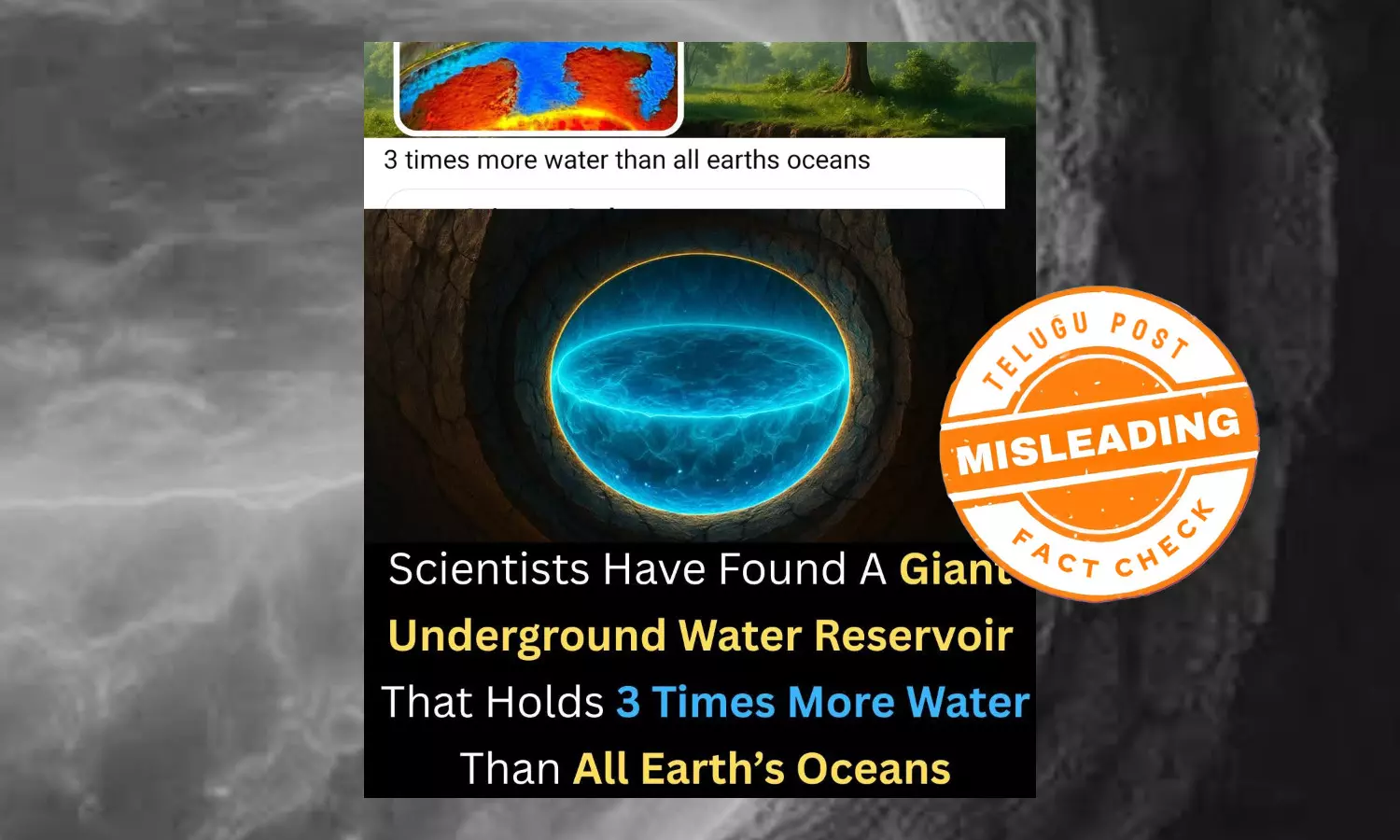Fact Check: Water Found Deep Inside Earth, But Not in Usable Liquid Form
We found the claim misleading. Scientists have identified mineral-bound water deep underground that could equal three times the volume of Earth's oceans but it's not liquid, and the evidence is limited to specific regions, not yet globally confirmed.

Claim :
Scientists Have Found A Giant, Underground Water Reservoir That Holds 3 Times More Water Than All Earth's OceansFact :
Scientists found that a mineral deep inside the Earth called ringwoodite holds water in a solid form. The amount could be up to three times more than all the water in Earth’s oceans, but it’s not liquid water like in oceans, nor is it in a usable form.
Earth, often called the "Blue Planet," earns this name from the abundance of water covering its surface. Approximately 71% of Earth's surface is water, with oceans alone accounting for about 96.5% of this volume. From towering glaciers to deep underground reservoirs, water is everywhere — but only a tiny fraction is accessible and safe for human use.
Despite the vastness of the oceans, just 2.5% of Earth's water is freshwater. Out of that, nearly 70% is locked away in glaciers and polar ice caps, while another 30% exists as groundwater. Less than 1% of all freshwater is easily accessible in rivers, lakes, and swamps — the sources we depend on most for agriculture, drinking, and sanitation.
The Earth's water is constantly in motion, cycling through evaporation, condensation, precipitation, and runoff. This hydrological cycle plays a crucial role in regulating climate, supporting ecosystems, and sustaining life. However, climate change is now disrupting this balance, intensifying droughts in some regions and flooding in others.
Human activity has placed significant strain on global water resources. Over-extraction, pollution, and poor management have led to declining water tables and contaminated supplies. Urbanization and industrialization have only intensified the problem, especially in developing countries where infrastructure lags behind population growth.
Preserving Earth's freshwater is becoming an urgent global priority. Efforts are underway to improve desalination technologies, invest in water recycling, and better manage agricultural consumption, which alone accounts for nearly 70% of freshwater withdrawals. But without stronger global cooperation and public awareness, the threat of a worldwide water crisis looms large.
Water is not just a resource — it's the foundation of all life on Earth. Understanding its scarcity amid abundance is key to ensuring a sustainable future. As the climate shifts and populations rise, the way we value and manage water today will determine the health of our planet tomorrow.
Amid this, a text is surfacing on social media claiming: "Scientists Have Found A Giant, Underground Water Reservoir That Holds 3 Times More Water Than All Earth's Oceans."
The claim link can be found here, and a screenshot is provided below.
Fact Check:
The claim is misleading. Yes, scientists have found a massive underground water reservoir in minerals that could hold roughly three times the volume of Earth's oceans. But it's not usable liquid water, and evidence is regionally based, not yet globally confirmed.
While discussing this claim with a climate expert, he informed us that recent scientific research suggests the existence of a vast underground water reservoir bound within minerals in the Earth's mantle, potentially containing up to three times the volume of all surface oceans. However, it's important to note that this is not free-flowing liquid water; rather, it is structurally trapped within rock-forming minerals such as ringwoodite. Moreover, current evidence remains geographically limited, and further studies are needed to determine whether these findings are globally representative.
While searching with the keywords, we found that The Brighter Side had published an article on it.
In the article, Brighter Side mentioned: In recent years, science has unveiled some astonishing secrets — from what lurks inside black holes to the discovery of a vast new “8th continent.” Even closer to home, researchers have uncovered a North American lake bigger than all the Great Lakes combined. But one of the most stunning discoveries lies not in space or on the surface, but deep beneath our feet.
Far below Earth’s crust, nearly 400 miles down, scientists found something astonishing: a hidden ocean locked inside rock. This underground sea isn’t like the oceans we see. Instead, its water is trapped within a mineral called ringwoodite, buried deep in the mantle.
This breakthrough is shaking up what we thought we knew about how water moves through our planet. Unlike surface water, this reservoir doesn’t exist as a liquid, solid, or gas. Instead, it’s held in a strange fourth state, suspended inside the rock like moisture in a sponge.
For years, scientists suspected water could hide within mantle rock. But this was the first time they found evidence of it stored so deep and in such vast amounts. The discovery came to light in a study titled Dehydration Melting at the Top of the Lower Mantle, which mapped this hidden system in remarkable detail.
Geophysicist Steve Jacobsen, one of the lead researchers, explained, “The ringwoodite is like a sponge, soaking up water.” He added that this mineral has a rare crystal structure. It pulls in hydrogen and locks away water in a way few other materials can.
According to Jacobsen, this isn't just a small deposit. “This mineral can contain a vast amount of water under the conditions of the deep mantle,” he noted. That means Earth’s interior could be far wetter than anyone imagined.
While publishing an article, indy100 mentioned that scientists previously discovered that water is stored inside mantle rock in a sponge-like state, which isn’t a liquid, solid, or gas, but instead a fourth state.
The scientific paper titled Dehydration Melting at the Top of the Lower Mantle was published in 2014 and laid out the findings.
“The ringwoodite is like a sponge, soaking up water. There is something very special about the crystal structure of ringwoodite that allows it to attract hydrogen and trap water," said geophysicist Steve Jacobsen at the time.
“This mineral can contain a lot of water under conditions of the deep mantle,” added Jacobsen, who was part of the team behind the discovery.
He added: “I think we are finally seeing evidence for a whole-Earth water cycle, which may help explain the vast amount of liquid water on the surface of our habitable planet. Scientists have been looking for this missing deep water for decades.”
Scientists made the findings at the time after studying earthquakes and discovering that seismometers were picking up shockwaves under the surface of the Earth.
Hence, we found the claim misleading. Scientists have identified mineral-bound water deep underground that could equal three times the volume of Earth's oceans — but it's not liquid, and the evidence is limited to specific regions, not yet globally confirmed.

